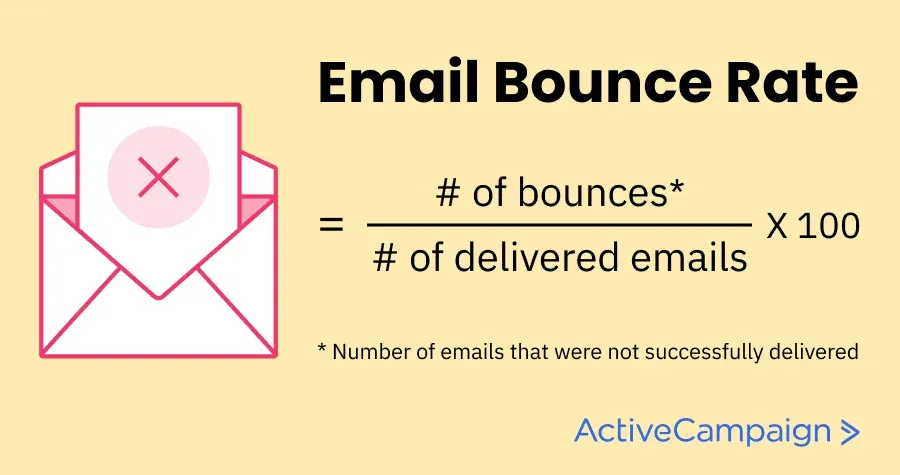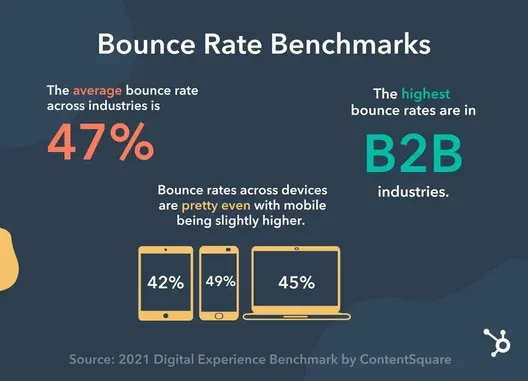It's finally time to push the send button after all of your hard work went into creating a great email for your subscribers. However, many subscribers have yet to receive them after you send them. Can you imagine the terror?
When it comes to email marketing, bounced emails aren't a newcomer. It happens whether your subscribers can no longer access their emails or the email server is under development.
The higher your email bounce rate, the more likely it will harm your email deliverability.
According to a Mailchimp study, the acknowledged standard for email bounce rate is roughly 2%. It means that for every 100 emails you send, two will be returned to you.
Meanwhile, if your email bounce rate exceeds 5%, it's essential to take action to reduce that number to a more manageable level.
Fortunately, lowering the email bounce rate does not have to be difficult.
Let's review everything there is to know about email bounce rates, including some effective strategies for ensuring your emails arrive in your subscribers' inboxes without a hitch.
What is Email Bounce Rates?

Email bounce rate refers to the percentage of sent emails that were not delivered to the recipient's inbox. These emails "bounce back" to the sender, indicating a delivery failure.
Now that we know bounce rates and why they matter, let's dive deeper. There are two main types of email bounces - hard and soft.
Types of Email Bounces

Hard Bounces:
- These occur when an email cannot be delivered to the recipient's address.
- Reasons for hard bounces include invalid email addresses, typos in the email addresses, or the recipient's email server being completely unavailable.
- Hard bounces are considered permanent delivery failures.
Soft Bounces:
- Unlike hard bounces, soft bounces are temporary email delivery failures.
- They occur when an email cannot be delivered to the recipient's address temporarily.
- Causes of soft bounces include a full mailbox, a recipient's server being temporarily down, or the email being too large to be delivered.
- Soft bounces generally resolve themselves, and the email can be delivered successfully on a subsequent attempt.
Causes of Email Bounces
Now that we know the types of bounces, let's explore the reasons behind them. The most common causes of email bounces include:
- Invalid email addresses: This happens when the recipient's email address is misspelled or doesn't exist.
- Full mailbox: If the recipient's inbox is packed to the brim and cannot receive any more emails, your message will bounce back.
- Blocked by recipient server: Some email servers have strict spam filters or security settings that may prevent your email from reaching the recipient's inbox.
- Content-related issues: Certain words or phrases in your email's content can trigger spam filters and result in a bounce.
Identifying and addressing these issues is important to minimize bounce rates.
Importance of Monitoring and Reducing Email Bounces
Email bounces can hamper your email marketing efforts significantly, leading to a reduction in your conversion targets. Let's dive into more details and understand the importance of reducing bounce rates.
- Email deliverability: High bounce rates can harm your email deliverability. Email service providers (ESPs) closely monitor bounce rates to determine whether or not your emails are of high quality. If your bounce rates are consistently high, your emails are more likely to end up in the spam folder or get blocked entirely.
- Sender reputation: ISPs evaluate your sender reputation based on bounce rates, spam complaints, and engagement metrics. A poor reputation can affect email delivery and prevent your messages from reaching subscribers' inboxes.
- Cost efficiency: Bounced emails waste valuable marketing resources and can lead to inflated email marketing costs. Sending emails to invalid or non-existent addresses is like throwing money down the drain. You'll improve cost efficiency and get higher returns by reducing bounce rates.
- List hygiene: Monitoring bounce rates and regularly cleaning up your email list helps maintain list hygiene. Removing invalid or inactive email addresses ensures that you're reaching a more engaged audience, improving the overall effectiveness of your email campaigns.
Suggested Reading:
How Email Bounce Rates are Calculated?
Calculating email bounce rates is essential for assessing the effectiveness of your email campaigns. The formula for determining bounce rates is simple: divide the number of bounces by the total number of emails sent.
Bounce Rate = (Total Bounces / Total Sent) * 100
For example, if you sent out 1000 emails and received 50 bounces, your bounce rate would be calculated as follows:
Bounce Rate = (50 / 1000) * 100 = 5%
This formula provides a percentage representing the proportion of emails that bounce back to the sender.
Importance of Tracking and Analyzing Bounce Rates
Tracking and analyzing bounce rates is crucial for several reasons. By closely monitoring these rates, you gain valuable insights into the performance and health of your email marketing campaigns.
Monitoring Campaign Health
Bounce rates serve as a barometer for campaign health. If your bounce rates are low, it indicates that your emails are successfully reaching their intended recipients.
On the other hand, high bounce rates suggest issues that need to be addressed, such as incorrect email addresses or poor list quality.
Identifying Delivery Issues
Bounce rates provide insights into delivery issues that may hinder your campaigns' success. By categorizing bounces into hard and soft bounces, you can identify specific problems.
Hard bounces usually indicate permanent delivery failures, while soft bounces are temporary and may resolve themselves over time.
Improving Email Practices
By analyzing bounce rates, you can identify trends and patterns that can help you improve your email practices.
For example, if certain types of content consistently result in high bounce rates, you can adjust your messaging or targeting to reduce bounces.
Impact of High Bounce Rates

High bounce rates can have detrimental consequences for your email marketing metrics.
Let's explore some of these negative impacts.
Email Deliverability Issues
Email service providers (ESPs) monitor bounce rates to signal email quality.
If your bounce rates are consistently high, ESPs may flag your emails as spam or even block them altogether.
This leads to a decline in email deliverability, meaning your messages have a higher probability of ending up in the recipient's spam folders or being undelivered.
Reputation Damage
High bounce rates can harm your sender's reputation. ISPs evaluate sender reputation based on bounce rates, spam complaints, and engagement metrics.
A good reputation increases the likelihood of your emails reaching subscribers' inboxes, making establishing trust with your audience easier.
Increased Spam Markings
Unwanted emails generate frustration, leading recipients to mark them as spam.
When your bounce rates are high, it's a sign that your emails are not reaching the intended recipients, potentially increasing the likelihood of them being marked as spam.
This affects your reputation and further decreases email deliverability.
Impact on Sender's Domain Reputation and ESP
A high bounce rate affects not only your sender reputation but also your entire domain.
ISPs may start associating your domain with poor email practices, leading to future emails from your domain being treated more harshly.
Additionally, ESPs may enforce stricter regulations or suspend your account if high bounce rates persist.
Understanding the impact of high bounce rates is critical for maintaining a healthy sender reputation and ensuring the success of your email marketing campaigns.
Suggested Reading:
Best Practices for Reducing Email Bounces
Reducing email bounces is crucial for maintaining a successful email marketing campaign.
Here are some best practices to help you minimize bounce rates and ensure your messages reach their intended recipients.
Validating Email Addresses Before Sending
Before sending out your emails, validating the email addresses on your list is essential. Email validation tools can check each email address's syntax, domain, and validity.
You can significantly reduce bounce rates and improve email deliverability by eliminating invalid addresses from your list.
Keeping Email Lists Updated and Opting for Double Opt-In
Regularly updating your email list reduces bounces. Remove inactive or bouncing email addresses and ensure you can email each subscriber.
Implementing a double opt-in process adds an extra layer of verification, requiring users to confirm their subscriptions before receiving emails.
This helps maintain a clean and engaged subscriber base.
Ensuring a Clear Unsubscribe Option in Emails
Providing a clear and easy-to-find unsubscribe option in your emails is a good practice and a legal requirement.
Honoring unsubscribe requests promptly helps prevent recipients from marking your emails as spam, which can harm your sender's reputation.
Ensure the unsubscribe link is visible and functional, allowing recipients to opt out effortlessly.
Maintaining a Good Sender Reputation
Building and maintaining a good sender reputation is crucial for email deliverability. To maintain a positive reputation:
- Send emails only to engaged subscribers who have willingly opted in to receive your messages.
- Only consistently send emails to active or engaged subscribers.
- Keep complaints, bounces, and spam markings to a minimum by following email best practices.
- Regularly monitor your sender's reputation using reputation monitoring tools.
- Follow industry guidelines and comply with email regulations.
- A strong sender reputation builds trust with ISPs and increases the chances of your emails reaching the inbox.
Monitoring and Analyzing Bounce Reports Regularly
Monitoring and analyzing bounce reports is essential for understanding and addressing bounce-related issues.
Pay close attention to bounce categories such as hard bounces (permanent delivery failures) and soft bounces (temporary delivery failures).
Analyzing these reports can help you identify patterns, troubleshoot issues, and optimize email practices.
Conclusion
A greater email bounce rate will not only harm your overall email deliverability but will also harm your sender's reputation. If you ignore your email bounce rate and deliverability, you'll see a drop in engagement, open rates, and click-through rates – all of which can lead to less sales.
Hopefully, the recommended practices described above have given you a better understanding of how to write emails that reach your subscribers' inboxes, allowing you to reap the full rewards of your email marketing ideas.
Best wishes for your next email marketing campaign!
However, if you're searching for an innovative chatbot platform to take your sales automation to the next level, we highly recommend Botpenguin.
Botpenguin's user-friendly UI and strong capabilities may assist you in automating your customer care, lead creation, and sales funnel, all while offering a smooth user experience for your clients.
So, why delay? Give Botpenguin a shot today and see for yourself!
Suggested Reading:
Frequently Asked Questions (FAQs)
Should the email bounce rate be under 1%?
While a lower bounce rate is generally preferred, the acceptable threshold varies based on factors like industry, list quality, and campaign type. Some sources suggest a reasonable 2% to 3% bounce rate.
What does a high email bounce rate mean?
A high bounce rate implies that many sent emails didn't reach recipients for various reasons, impacting the email campaign's effectiveness. These issues range from invalid addresses to server problems.
What is a good bounce rate?
A desirable bounce rate is typically under 2% to 3% but can differ by industry and campaign context. Regular monitoring is essential for a healthy email list and a positive sender reputation.
How do email authentication and verification contribute to reducing bounce rates?
Implementing authentication protocols (SPF, DKIM, DMARC) and email verification services can decrease bounce rates, enhance email deliverability, and boost campaign credibility.



